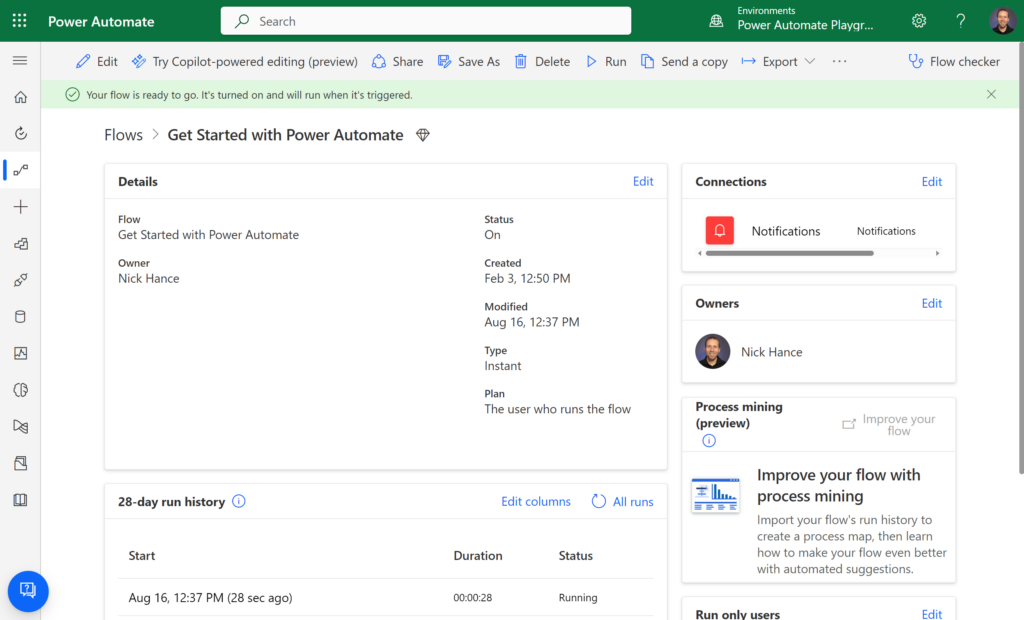Unleashing Power Automate for Beginners: Simplify your Workflow!

Prepare yourself to embark on an enlightening journey, aimed squarely at you, a beginner stepping into the world of Power Automate. This piece will demystify this Microsoft platform, bring clarity to its benefits, explain its components like connectors and APIs in a way you can understand, and most importantly, justify why and when it makes sense for you to use it.
You will learn:
- How to uncover the vast potential of Power Automate
- A simple explanation of connectors and APIs
- The distinction between Power Automate and Power Automate Desktop
- How to understand the concept of ‘flows’ in Power Automate
- A strong use case for using Power Automate
- A peek into the added perks that come with the platform
Unleashing Your Potential: An Easy Guide to Power Automate for New Users
Imagine a world where you don’t have to find a developer to write code to automate your systems. “Impossible,” you say. Well, not anymore! This is where Power Automate comes into play. Power Automate is a no-code/low-code platform by Microsoft. “What’s that?” you ask. Simply put, it’s like getting a shiny, new tool belt that allows your Microsoft services to interact with over 1000 different web services. All of this is built so that beginners like you can put together your own automations without writing a single line of code.
Now, let’s get to the meaty part – connectors. Every single one of the 1000-plus connectors in Power Automate acts like a translator, turning your intent into a language any web service can understand. It’s like going to a foreign land and having a translator with you to communicate with the locals. But wait! “What is an API?” Let me break that down too.
APIs for Beginners. What is an API?
API stands for “Application Program Interface.” Each web service has a different purpose and each one has made its own decisions about how to operate. The API is a way for each web service to describe to the rest of the world how it is to be used.
APIs aren’t as complicated as they may seem. Consider them as waiters at your favorite restaurant. You put in your order (the request), and they carry it to the kitchen (the web server) and bring back your food (the response). It’s all simple, get it? The API is like a menu that describes each item and contains pictures so you know what to expect when you place an order.
Power Automate then is a service that gathers menus from over 1000 different services and presents them all in the Power Automate interface so you can use them all together. So with a dash of “Website form submission” from Gravity Forms you can sprinkle in a “Get file content” to SharePoint and then add “Send a message to a channel” in Microsoft Teams. Pick and choose from all of the services, build your flows, and you can make something truly useful to your business!

In the world of Power Automate, each automation you build is termed a ‘flow’. These are the series of tasks that you set the program to do. Each flow has exactly one trigger and one or more actions that follows it. When you build a flow you will be interacting with at least one, but usually many different connectors.
I see you asking, “All this sounds cool, but why should I use it? When would it make sense?”
Think about the tasks you or your team might need to perform every day. What can be done by computer? What is a “nice to have” that you can’t quite justify hiring a programmer to build?
That’s when Power Automate steps in. Cutting down on manual redundant work in a platform you can manage yourself. Now that’s neat, isn’t it?
Discover the Benefits that Come with Power Automate
Wait! The buck doesn’t stop here. With power automate comes perks, umm… LOTS of them! You get a log of all flow runs. Or maybe rerun those flows that have an error along the way. But there’s even more- you get Microsoft’s process monitor alerting you when flows have issues. All of these would come at an extra cost if you hired a developer, but not when you get them for free with the Power Automate platform.
I just want you to remember one thing here – that I believe in YOU! With Power Automate, you’re at the wheel, navigating your way smoothly over tedious tasks and manual labor. You can do this!
Introducing Fix-a-Flow with Reenhanced
As we reach the end here just want to mention Reenhanced’s Fix-a-Flow service, we’ll help you sail through any hiccups you might run into while dipping your toes in using Power Automate. We will help get your flow running and make sure its done in a way to maximize its service life. A well built flow can run for years without issue!
FAQ
What exactly is Microsoft’s Power Automate?
Power automate is defined as a no-code/low-code platform offered by Microsoft. Think of it as a tool belt which enables seamless communication between your Microsoft systems/services and over 1000 web platforms – it’s like a social butterfly in the expansive network world.
What role do Connectors play in this system?
The thousand plus connectors available within the system provide a list of actions and triggers for each service. It’s similar to having an interpreter readily available during foreign travel!
How can one understand APIs better?
APIs can be equated to waiters in a restaurant who take your order (the request), communicate it efficiently to the kitchen (web server) and ensure that your meal (response) reaches you on time.
How does ‘Power Automate’ differ from ‘Power Automate Desktop’?
Though their name seems similar don’t get fooled. While Power Automate helps automate systems/services without needing coding skills, Power Automates Desktop actually facilitates remote control over computers.
Why should one opt for using ‘Power automate’?
Apart from automating repeat tasks rendering them efficient automated cycles thus reducing manual redundant work significantly – there are numerous additional perks accompanying power automate! Examples include zero charges for logging all flow runs or having quick reruns if required coupled with vigilance alerts by none other than Microsoft itself.
